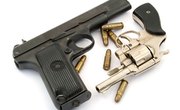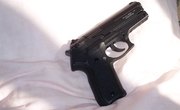Since 1968, American firearms manufacturers and importers have been required to include a serial number on every gun, making them easily traceable by law enforcement when investigating a crime. The general public has limited access to a gun's history and only a few ways to trace it by serial number.
How to Trace a Gun
The Bureau of Alcohol, Tobacco, Firearms and Explosives has the sole center in the U.S. that can address whether a gun has been involved in a crime. Although you may wish to know such things about your gun, only law enforcement involved in a bona fide criminal investigation can submit a request for this information. The only way that your gun will ever be traced through the ATF is if you're the subject of a criminal investigation, including a DUI where you had your firearm with you.
Looking Up a Gun's Serial Number
Searching a gun's serial number online will tell you the make, model and, sometimes, the year of a gun's manufacture. Entering the words "gun serial number" in the search bar before the actual number yields the best results. For example, entering the string, "gun serial number 335-71633" yields search results showing that the piece is a Ruger SR9 pistol manufactured in 2015. If your full serial number doesn't produce results, try shortening it to the first set of numbers before the hyphen to find out the make and model.
Is It Stolen?
It's a good idea to do your due diligence before buying a gun to make sure that it isn't stolen. The best way to have peace of mind is to buy your new firearm through a licensed gun dealer. If you're getting your gun through a private individual, however, there are a number of ways you can research a gun's serial number to see if it is stolen.
- Stolen firearms databases such as HotGunz let you search serial numbers of guns that owners have reported as missing. Although some law enforcement agencies do enter information on these sites, they are not a comprehensive list. If the gun you buy was stolen but not reported on one of these sites by the owner as a missing firearm, then visiting the site won't help you.
- Contact your local law enforcement agency to see if they're willing to run the serial number of a firearm through the FBI's National Crime Information Center. The NCIC's Stolen Gun File contains the serial numbers of stolen firearms as well as those of recovered guns that haven't had ownership established. The law enforcement agency usually requires you to bring the gun in person since they will need an accurate description and will confiscate the gun if it shows as stolen.
Tips
The ATF doesn't mandate that you research a gun that you're thinking of buying, and a bill of sale from the person you buy one from is not required. However, should you inadvertently wind up as the owner of a stolen firearm, a bill of sale showing the date of sale, gun serial number and description – along with the signatures of both parties – can keep you in the clear. Keep the bill of sale indefinitely in a safe place, such as a safe deposit box, in case it's ever needed.
References
- Bureau of Alcohol, Tobacco, Firearms and Explosives: ATF Guidebook
- Bureau of Alcohol, Tobacco, Firearms and Explosives: ATF Firearms Tracing Guide
- Parnell Defense: DUI While Armed
- Ruger: SR9 Pistol
- HotGunz: Stolen Firearms Database
- ATF: What Recordkeeping Procedures Should Be Followed - Unlicensed Individuals
Tips
- If the gun was used in a recent crime, it will be confiscated.
Writer Bio
Indulging her passion for wide open spaces and outdoor fitness through the written word on a full-time basis since 2010, author Jodi Thornton-O'Connell takes the mystery out of outdoor skills and guides readers to discover fun ways to physically connect to natural surroundings.



